

This is part of our special feature on Crime and Punishment.
In recent years, as concerns about the American prison-industrial complex continue to grow, historians have increasingly looked back at the post-emancipation South in search of the origins of the modern carceral system. This work has almost exclusively focused on the system of convict leasing, in which inmates (the majority of whom are African American) served their sentences not within prison walls, but instead as hired laborers for private contractors.[1] The similarities between convict leasing and modern mass incarceration are uncomfortably clear: in both systems, convicts are cordoned off from larger society and coerced into the performance of menial labor, from which they gain neither profit nor personal advancement. But as much as histories of convict leasing point to the future, they also lean on the past, painting the system as the natural successor to slavery. In this version of history, slavery, convict leasing, and modern incarceration merge to form an unbroken legacy of American coercion of unskilled and easily replaced black labor.
However, there was nothing inevitable about the rise of convict leasing—particularly in the tumultuous political climate of the Reconstruction South. In the late 1860s and early 1870s, the state of South Carolina attempted a different model of incarceration, one in which the carceral project would revolve around the creation and employment of skilled laborers. In so doing, state legislators and penitentiary officials merged the practices and prejudices of the slave past with the progressive politics of the Reconstruction era, articulating a vision of the artisan trades as both a means of profit and a mechanism of rehabilitation and reform. Their experiment failed, crippled by financial troubles and done in by shifting political tides. In the process, however, it exposed a more foundational flaw: the carceral project attempted in South Carolina proved fundamentally at odds with the state’s social realities.
South Carolina’s new state penitentiary reflected a significant break from the state’s previous methods of punishment and incarceration. Across the American South, slavery had long operated as the primary mechanism for the control and punishment of African Americans, who whites considered the main source of criminality.[2] Confident in the power of individual slaveholders and local jails to handle the state’s punitive and carceral needs, white South Carolinians had previously considered a centralized prison system unnecessary. The death of slavery, however, triggered a reassessment.[3] State legislators, pushed by provisional Governor James L. Orr, authorized the construction of a new penitentiary in September of 1866. While neither Orr nor the legislators explicitly stated the racial purpose of this new institution, statistics alone demonstrate the penitentiary’s target population. Of the eight hundred and ninety-nine inmates whose records survive from its first five years of existence, 83 percent were African American (African Americans composed 59 percent of South Carolina’s population in 1870).[4]
Despite its obvious demographic imbalances, this new institution did not take on the form we might expect (given both the state’s history and popular understandings of post-emancipation incarceration). South Carolina’s embrace of convict leasing came only after the fall of Reconstruction in 1876.[5] In the years in between, penitentiary officials attempted a system very different from the one that would succeed it, a system in which economic imperatives merged with reformatory impulses to craft an unexpected vision of carceral labor. Here, penitentiary officials and legislators planned to train and employ convicts internally in the artisan trades, a far cry from the unskilled manual labor considered the carceral norm. The artisan skills taught to inmates would be employed on-site to the benefit of the institution during their imprisonment, and to their own benefit upon release. Profit would thus be combined with education to satisfy both the budget conscious and the reform-minded.
At least in theory, the South Carolina penitentiary would be a profoundly different carceral experiment from convict leasing, one enabled by the state’s racial and political landscape. Along with its majority-African American population, South Carolina also featured the only majority-African American legislature during the Reconstruction years. This legislature was not the one that established the penitentiary—that had been the work of an interim, all-white state legislature—but it was the one which oversaw its early years. For African American politicians and their white Republican allies, the greater oversight that came with a centralized state penitentiary rendered it preferable to more localized forms of incarceration. As a result, even as other states in the South adopted convict leasing, South Carolina’s Republican legislature resisted, although their own artisanal penitentiary proved less profitable—and less progressive—than imagined.
In June of 1867, the first inmates arrived at the new penitentiary, though the building designed to house them remained unfinished.[6] This was intentional: the same act that authorized funds for the penitentiary’s establishment called for temporary facilities to house one hundred convicts. They were to be directed in “getting out material and constructing, as far as is practicable, the necessary permanent buildings and enclosures.”[7] However, the intentions of penitentiary officials went beyond a finite construction project. They intended to finance the institution’s daily operations through the steady employment of convict laborers in internal industries. The state’s primary industry, agriculture, proved impractical in this regard, as the institution lacked the necessary land for large-scale production. Instead, penitentiary officials turned their attention to the skilled craft trades (including shoe-making, weaving, blacksmithing, and carpentry), which could be carried out within prison walls.
By planning for the employment and training of inmates in the artisan trades (rather than the brutal unskilled labor that characterized the convict leasing system), legislators and prison officials pursued a vision fundamentally at odds with the traditional understanding of the South’s post-emancipation carceral system. In fact, South Carolina’s plans matched with the recommendations of the period’s leading experts on prison reform. In January of 1867, E.C. Wines and Theodore W. Dwight, the Commissioners of the Prison Association of New York, issued an influential study on prison reform; among other recommendations, Wines and Dwight called for widespread occupational training within penitentiaries. To the two authors, the reformatory vision of the penitentiary depended on the instillation of honest habits through hard work, preferably the artisan trades: “Make a criminal a good mechanic, and you have gone far towards making him an honest man.”[8]
The similarities between this report and the South Carolina penitentiary’s initial vision were not accidental. According to the Governor’s personal secretary, it had been a key reference for planning.[9] In January of 1868, Thomas B. Lee, Acting Superintendent and lead architect and engineer of the penitentiary, reported to the State Legislature that convict labor had begun to substitute for the original construction crew, with convicts working as stone-cutters, carpenters, and bricklayers.[10] Other industries were also underway: the inmates’ shoes were made by convict shoemakers, and convict weavers wove the cloth for their apparel. The penitentiary still had a long way to go, however, before true self-sufficiency. According to Lee, this was due to the limitations of this convict labor force, which required extensive occupational training. Nevertheless, he had high expectations, promising the governor that within a few years, the institution would “not only be of no expense to the State, but a source of income.”[11] And indeed, advances were made in turning the prison into a profit-making undertaking: in 1869, more than fifteen hundred pairs of brogans, almost two hundred pairs of half-soled shoes, and sixty women’s garments were produced for sale.[12]
The success of the penitentiary’s twin missions of reform and profit would depend on the creation and maintenance of a skilled inmate population capable of supporting its internal industries. This would, in turn, require a significant investment in education: after all, trades like shoemaking, blacksmithing, and marble cutting traditionally require multiple-year apprenticeships. Undoubtedly, some degree of instruction took place within penitentiary walls. Henderson White, an African-American carpenter, came to the penitentiary soon after it opened, not as an inmate but as a hired laborer. As part of his responsibilities, White trained convicts in carpentry.[13] Convict Joe Williams observed fellow inmates working in shoemaking, carpentry, blacksmithing, and tailoring; at least one of the carpenters was in the process of learning his trade.[14]
Inmate records, however, call into question the scale and necessity of labor training within the penitentiary. A significant minority of the inmates entered already skilled: in the first five years, at least 242 of the inmates identified themselves as artisans upon arrival, composing more than a quarter of the identifiable prison population.[15] These numbers do not fit with artisans’ representation in the larger South Carolina population: at the very highest, artisans would not have exceeded even 5 percent of the labor force.[16] The convict population of the state penitentiary was therefore disproportionately skilled.
This outsized representation of artisans appears to have weakened penitentiary officials’ commitment to their educational mission. According to one report on the penitentiary’s labor force, “Convicts are detailed for the various classes of labor, according to their capabilities, without regard to color, white and black working in the same gang.”[17] Many of the available positions in certain skilled trades would thus have been filled by workers who arrived already trained. In January of 1868, when inmates had assumed responsibility for shoeing the prison population, there were at least six professional shoemakers in residence, rendering shoemakers-in-training redundant.[18] Former inmate Joe Williams testified to this: “All the shoemakers…came in with trades.”[19] For these shoemakers, incarceration would not be a time for them to train in a new skill, but rather to use their already-existing abilities to the benefit of the state. Meanwhile, unskilled inmates were shunted into other occupations, the most common of which—quarry work—could not be considered equivalent to shoemaking, either in terms of earning power or social prestige. If the penitentiary was designed to prepare inmates for economic success upon release, then it did so in an uneven fashion.[20]
The reliance on already trained artisans implied that penitentiary officials’ commitment to the institution’s reformatory vision could be compromised when labor efficiency and profit were involved. After all, the penitentiary proved an expensive proposition, and as time passed, it became clear that internal industry was not producing the income legislators and officials had imagined. Thirteen months after construction began, more than seventy-thousand dollars had been spent, and the end was far from in sight. In 1873, Superintendent J.B. Dennis reported over one hundred thousand dollars in debt.[21] Whatever its reformative possibilities, the artisanal penitentiary had proven a financial failure. Conditions within the prison were not much better, with reports of overcrowding, unsanitary conditions, and excessive physical punishment plaguing penitentiary authorities.[22]
As officials searched for a solution, they looked away from their initial reformatory vision and towards other experiments in prison labor occurring nearby. Even as South Carolina was attempting this carceral experiment, its fellow Southern states were moving in a radically different direction. In 1868, Georgia became the first state to adopt a convict leasing system, and other states steadily followed suit. That South Carolina’s own carceral experiment survived to the end of formal Reconstruction reflects the relative power of its black political class during this period. Throughout Reconstruction, in the face of spiraling debts and miserable conditions, African-American politicians nevertheless staunchly resisted the convict lease. The state’s turn to this system, therefore, stemmed not so much from its financial woes as from its changing political fortunes. When the state government fell to Democrats in the violent election of 1876, convict leasing proved one of the first items on the new government’s agenda. [23] In later years, manufacturing industries continued limited operations within the walls of the penitentiary, but most convicts went into the lease system; all pretense of reform or education had been thrown aside in the pursuit of naked profit.
Still, as the example of South Carolina demonstrates, there was nothing inevitable about the ascension of convict leasing in the post-emancipation American South, despite how seamless the transition from slavery to leasing may appear. Certainly, the financial pressures faced by Southern penitentiaries contributed to this transition, yet we must also confront its underlying racial logic. In a society where the white population had long considered the sale of and profit from black bodies and black labor to be not just acceptable, but a social good, the embrace of convict leasing came easy. The South Carolina Penitentiary, however, demonstrated an alternative use of the slave past in the crafting of post-emancipation incarceration. After all, the initial plans for an institution centered around artisan training and employment came not from the Republican legislators who fought to defend this vision against convict leasing, but rather from a previous, all-white legislature.
What made a group of conservative white legislators consider the artisan trades the proper form of employment in an institution they intended to house a majority-black inmate population? If we assume that whites saw African Americans only as a source of unskilled labor, then this decision seems incomprehensible. The inmate records alone, however, testify to a different relationship between white South Carolinians and black labor. Consider, for example, the case of Cyrus Oliver, the first black artisan in the inmate register. Oliver, a carpenter by trade, was forty years old when he entered the penitentiary, likely closer to the end of his working life than the beginning. He, like the vast majority of incarcerated black artisans in this period, would thus have learned his trade under slavery. Legislators in 1866, some of whom may well once have owned enslaved artisans themselves, would thus have been well-accustomed to both employing and, crucially, coercing black artisan labor. In this artisan penitentiary, Northern theories of reform could mesh with Southern notions about the capability and utility of black labor in productive and profitable ways.
Even if the penitentiary had survived the end of Reconstruction with its initial reform mission intact, however, evidence from these early years demonstrates the incompatibility of its reform project with the social realities of the post-emancipation South. According to New York Commissioners Wines and Dwight, “To teach a convict a trade is to place him above want, that is, to remove from his path one of the greatest occasions of crime.”[24] If many of the convicts in the penitentiary had been pushed to crime by poverty and a lack of opportunity, then training in the artisan trades would seem to be the path to an honest life. The inmate records of South Carolina’s Reconstruction penitentiary demonstrate the exact opposite conclusion: artisans, traditionally not counted among the underclass, appear to have been comparatively more vulnerable to sentencing and imprisonment than their unskilled counterparts.
Focusing on black male artisans proves instructive here. These were not members of the unskilled or unemployed underclass, but rather the post-emancipation black middle class. It would thus be reasonable to assume that their comparatively greater social capital, earning power, and educational achievement would make them less likely than their unskilled counterparts to be incarcerated. And yet, 26.7 percent of African American men who entered the penitentiary in its first five years worked in the skilled trades, composing more than twenty percent of the overall inmate population.
We have no way to know what percentage of these artisans actually committed the crimes for which they were sentenced: in this historical moment, convictions cannot be taken as proof of guilt. African Americans were systematically accused, arrested for, and convicted of crimes at rates astronomically higher than those of the white population. At least some of these imprisonments stemmed from trumped up or fabricated charges; a number of black inmates, artisans included, received pardons after proof of their innocence emerged, although most were not so fortunate. This exposes a fundamental flaw in the penitentiary’s reform agenda: the artisan trades could do nothing to reduce criminal behavior if the inmates in question had committed no real crime in the first place.
In fact, employment in the artisan trades apparently made African-American men more vulnerable to incarceration. Considering the ways in which white Southerners used the courts to punish African Americans they considered troublesome, dangerous, or even just inconvenient, the social and economic elevation associated with these trades may well have been a key factor in this disproportionate rate of imprisonment. Black artisans were prominent members of their communities, identifiable both by their higher social and economic position and also their membership in an occupational minority. Long suspected by whites to be key contributors to unrest and rebellion during the antebellum period, they likely remained special targets of surveillance after emancipation.
The vast majority of African Americans sentenced in Southern courts arrived there accused of property crimes, as was the case for the black artisans studied here.[25] Some of these would have stemmed from false accusations: the greater earning power of black artisans meant that they might have more personal property than other African Americans, opening them to prosecution by whites who considered this property ownership suspicious. This high rate of property crimes, however, also raises doubts about the potential of the artisan trades to leverage former inmates out of poverty. After all, high rates of theft among black artisans may well have been indicative of significant economic problems. This, in turn, provides yet another argument against the reformative power of artisan training: if artisans outside the penitentiary were struggling financially, then what hope did former convicts have of leveraging their newly acquired trades into economic stability?
The South Carolina State Penitentiary’s early years testify to a different potential future for the nation’s carceral system, one in which prisons did not contribute to the deskilling of inmates, but rather were institutions that looked to both generate profits and encourage reform by promoting skilled labor. The state’s racial past made this carceral experiment possible, allowing white South Carolinians to conceive of a system in which convict labor would not be menial. But the state’s racial present crippled the experiment from the get-go, as the world outside prison walls defied the theoretical promise of a penitentiary which at least in part valued and supported skilled African-American artisans. Racial logic and carceral logic combined to overwhelm the reformist possibilities of the artisanal penitentiary and to spur the South’s descent into convict leasing, leaving a legacy of one of the most racist and brutally exploitative regimes of penal labor in its wake, a legacy that continues to endure.
Anne E. Kerth is a PhD candidate in the Department of History at Princeton University. A historian of nineteenth-century African-American history and U.S. labor history, she is currently completing a dissertation entitled “‘Art, Trade, and Mystery’: African-American Artisans in Nineteenth-Century South Carolina.”
Photo: Convict chain gang and prison guard in Oglethorpe County, Georgia, May 1941 | Shutterstock
Published on November 8, 2018.
References:
[1] Some of the most influential books in the growing body of historical literature on mass incarceration, the late nineteenth century Southern penal system, and convict leasing include Michelle Alexander, The New Jim Crow: Mass Incarceration in the Age of Colorblindness (New York: New Press, 2010); Douglas A. Blackmon, Slavery by Another Name: The Re-Enslavement of Black Americans from the Civil War to World War II (New York: Doubleday, 2008); Matthew J, Mancini, One Dies, Get Another: Convict Leasing in the American South, 1866-1928 (Columbia, SC: University of South Carolina Press, 1996); Sarah Haley, No Mercy Here: Gender, Punishment, and the Making of Jim Crow Modernity (Chapel Hill, NC: The University of North Carolina Press, 2016).
[2] Mark Colvin, Penitentiaries, Reformatories, and Chain Gangs: Social Theory and the History of Punishment in Nineteenth-Century America (New York: St. Martin’s Press, 1997), 203-207.
[3] Henry Kamerling, Capital and Convict: Race, Region, and Punishment in Post-Civil War America (Charlottesville, VA: University of Virginia Press, 2017), 23-32. North Carolina and Florida, the only other Southern states not to have established a state penitentiary during the antebellum era, quickly followed suit, while other states refashioned their existing penal institutions to meet their new purpose. Edward L. Ayers, Vengeance and Punishment: Crime and Punishment in the 19th-Century American South (New York: Oxford University Press, 1984), 188-189.
[4] Descriptive Roll of Convicts, 1867-1872. Unfortunately, the first few pages of this prison register are lost, leaving the identities and occupations of the first sixty inmates unknown. Additionally, although registers from the post-Reconstruction period have survived as well, the years 1872-1876 are missing. A Compendium of the Ninth Census (June 1, 1870), 8, 12.
[5] Kamerling, Capital and Convict, 32-53.
[6] Descriptive Roll of Convicts Received at the South Carolina Penitentiary, Columbia, South Carolina, June 19, 1867-May 28, 1872. South Carolina Department of Archives and History, Columbia, SC.
[7] “AN ACT to Provide for the Establishment of a Penitentiary,” September 21, 1866, Statutes At Large of South Carolina, Volume XIII, containing the Acts from December, 1861, to December, 1866, 36628.
[8] E.C. Wines and Theodore W. Dwight, Report on the Prisons and Reformatories of the United States and Canada, made to the Legislature of New York, January, 1867 (Albany, NY: Van Benthuysen & Sons’ Steam Printing House, 1867), 264.
[9] Testimony of F.G. DeFontaine, Columbia, SC, March 27, 1868, “Proceedings of Commission to Inquire into the Management and Treatment of Prisoners in Penitentiary,” in Message No. 1 of His Excellency Gov. J.L. Orr, with Accompanying Documents, prepared for the Called Session of the Legislature, July, 1868 (Columbia, SC: Phoenix Book and Job Power Press, 1868), 118.
[10] Thomas B. Lee, Jr. to James L. Orr, Columbia, SC, January 14, 1868, in Message No. 1 of His Excellency Gov. J. L. Orr, with Accompanying Documents. Prepared for the Called Session of the Legislature, July, 1868, 78.
[11] Ibid., 81.
[12] Kamerling, Capital and Convict, 41.
[13] Testimony of Henderson White, November 18, 1868, “Examination of Witnesses in the Matter of Investigation Concerning the Management of the South Carolina Penitentiary,” in Report of the Comptroller General to the General Assembly of the State of South Carolina, November 1868 (Columbia, SC: John W. Denny, 1868), 319.
[14] Testimony of Joe Williams, “Proceedings of Commission to Inquire into the Management and Treatment of Prisoners in the Penitentiary,” Message No. 1 of His Excellency Gov. J.L. Orr, July, 1868, 104.
[15] Descriptive Roll of Convicts, June 19, 1867-May 28, 1872.
[16] The 1870 census recorded only 5.2% of employed South Carolinians as engaged in the occupational category that encompassed the artisan trades (Manufactures, Mechanical, and Mining Industries). Since this labor category also incorporated miners, factory workers, and sundry other non-artisanal occupations, the actual percentage of artisans in the labor force would have been less than 5% of the working population. Compendium of the Ninth Census (1870).
[17] Report of the Commission, Columbia, SC, April 2, 1868, in “Proceedings of Commission to Inquire into the Management and Treatment of Prisoners in the Penitentiary,” Message No. 1 of His Excellency Gov. J.L. Orr, July, 1868, 123.
[18] Descriptive Roll of Convicts, 1867-1872. To put matters in perspective, in these five years, at least 65 black shoemakers were incarcerated; in 1870, there were only 90 African-American shoemakers in all of Charleston. In that year, African Americans composed 60% of the city’s shoemakers. Bernard Powers, Black Charlestonians, 270.
[19] Testimony of Joe Williams, “Proceedings of Commission to Inquire into the Management and Treatment of Prisoners in the Penitentiary,” Message No. 1 of His Excellency Gov. J.L. Orr, July, 1868, 104.
[20] Lee, Jr. to Orr, January 14, 1868, in Message No. 1 of His Excellency Gov. J. L. Orr, with Accompanying Documents. Prepared for the Called Session of the Legislature, July, 1868, 80.
[21] Kevin Krause, “The Big House and the Madhouse: Institutional Reform and the State in Tillman-Era South Carolina,” The South Carolina Historical Magazine 115 No. 3 (July 2014), 219.
[22] Ibid., 219.
[23] Kamerling, Capital and Convict, 39-49.
[24] Wines and Dwight, 264.
[25] Descriptive Roll of Convicts, 1867-1872.




